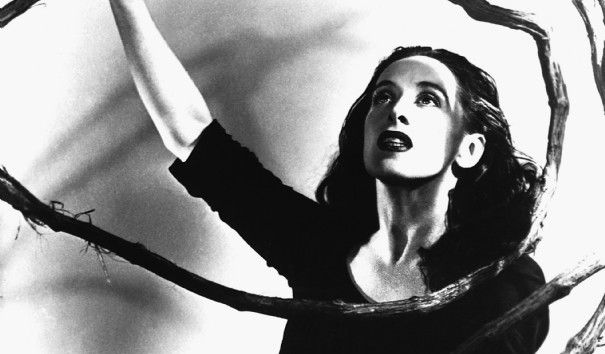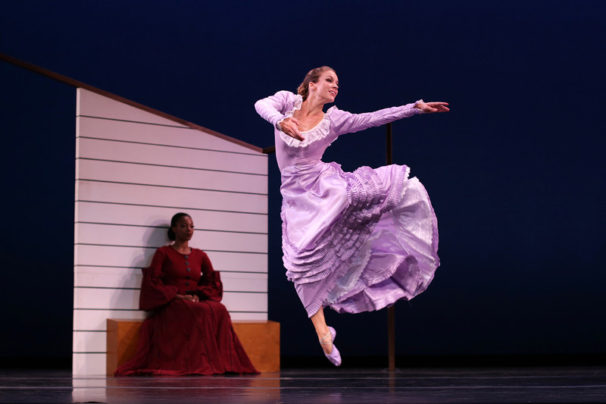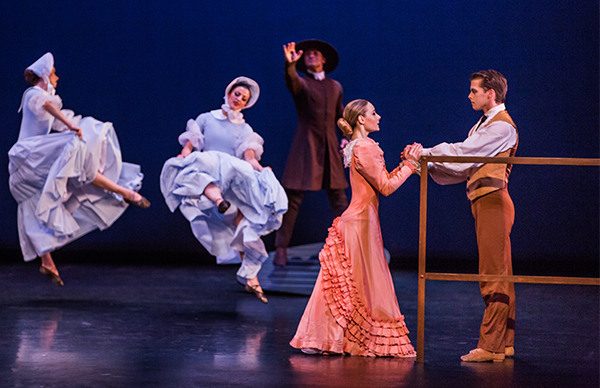
ed. note: This story by dance critic Debra Levine, commissioned and originally published by the Younes & Soraya Nazarian Center for the Arts, is reprinted with permission.
When Martha Graham placed a single bare foot—famously small, her feet had enviable high arches—on the stage of New York’s 48th Street Theater in her 1926 debut as an independent choreographer, she made dance history. Newly departed from her Denishawn dance-beginnings, the intense young woman, abetted by her musical director Louis Horst, rented the theater for a program of 18 short works, mostly solos. Graham was deploying a powerful means of self-expression—her highly trained body—to give form to her passionate thoughts and feelings. Ninety-five years later, Janet Eilber, artistic director of the Martha Graham Center of Contemporary Dance, who as the company’s former lead dancer inherited many of Graham’s massive leading roles (Graham died, age 96, in 1991), brings the troupe she has directed since 2005 for its fourth return appearance at The Soraya.

The fleet and venerable sixteen-member Martha Graham Dance Company, dancing at a remarkably high level, opens The Soraya season’s dance roster on Friday, November 19. Eilber’s curated program forms a stepping-stone tour through a Graham chronology. The Los Angeles-based music collective, WildUp, will provide live accompaniment—always a bonus for a dance concert particularly at a house known for acoustics. Conducting WildUp will be its dance-enamored founder/director Christopher Rountree.
The program’s three historic masterworks dot Graham’s creative trajectory, dating respectively from 1937, 1944 and 1948. These vintage works not only lend context to each other, they set the stage for the evening’s fourth work, a brand-new piece by a hot choreographer of today, Andrea Miller.

Graham’s beloved signature work, Appalachian Spring (1944), in its 77th anniversary, is the Soraya show’s headliner. Aaron Copland’s expansive, Pulitzer Prize-winning score of the same name, which propels Graham’s joyous ode to Americana, will receive live accompaniment by WildUp in the pit. Diversion of Angels (1948), an uplifting, lyrical work for three romantic couples to music by Norman Dello Joio (again, performed live) is considered Graham’s projection of her own experience in love. A Couple in Red embodies romantic love; a Couple in White, mature love; and a Couple in Yellow, a flirtatious and adolescent love.
Scavengers (2021), with a soundscore by Will Epstein, one anticipates, will reflect dance maker Andrea Miller’s background in Israeli “gaga,” a deep-digging dance technique that taps unvarnished emotion. Eilber calls this work for four couples and a soloist, “elemental, or primal.” Critics have labeled Miller’s oeuvre “as sexy as high art can get” and “as ancient as [it is] ultra-modern.” Scavengers is hot off the press; it just had its world premiere at New York’s Joyce Theater in October.
Amid all this enticing repertory, however, the work of greatest fascination may be the program’s briefest. It is a barebones, seven-minute solo, Immediate Tragedy (1937), choreographed and danced by a stricken Martha Graham as her response to the humanitarian crisis unleashed by the Spanish Civil War. Graham danced the work, which was subtitled “A Dance of Dedication,” one time only. Graham’s biographer and friend, Agnes de Mille, wrote that Immediate Tragedy “left a deep mark” on its audience. Then it disappeared into the ether.
In a fortuitous fluke, Neil Baldwin, a Graham scholar, surfaced and shared with Eilber “found” materials related to Immediate Tragedy — scant writings by Graham and, importantly, photographic contact sheets that reveal the raven-hair dancer studiously performing the work in a white stretch top and black skirt. Eilber, fluent in Graham-ese, knew she could add movement transitions to knit the fixed images of the photos into a dance. She started to noodle. She tasked Rountree (the Graham Company was first artistically paired with WildUp at The Soraya in 2017) with creating a score from the equally sparse leave-behinds by the work’s composer, the avant-gardist Henry Cowell.
Then came COVID.

The advent of a deadly pandemic put arts projects, as well as lives, in the waiting room. But one thing seemed clear to Eilber. Similar to Spain in the 1930s, America in 2020 was experiencing the creep of fascism. Eilber believed that Graham’s brief solo would give audiences a rare glimpse into an ardent female artist deeply engaged with the issues of her time.
The Soraya’s Executive Director Thor Steingraber played a galvanizing role in the revival of Immediate Tragedy. In an act of arts leadership, Steingraber tempered his necessary cancellation of last spring’s Graham booking with an offer.
“Thor called me up,” said Eilber, remembering the start of a saga. “This was late March right after everything shut down,” she said, speaking from New York. That simple phone call would spawn a long-distance creative venture shared by two dozen artists. “Thor asked me, ‘What can we cook up to put people on salary and give them a creative outlet?’”
That was all Eilber needed to hear. In a flash of recognition, she knew she had the goods—Immediate Tragedy. Deeply believing that “[t]he passion with which Graham worked is palpable, and … is sorely needed now,” she signed on.
Having found a “silver lining in an otherwise difficult moment,” Steingraber made his pivot. He underwrote a plan for the virtual workshopping of Immediate Tragedy via Zoom. On June 19, 2020, a Friday afternoon, The Soraya, Graham dancers, and WildUp musicians premiered Immediate Tragedy as a collaborative digital experience. The ten-minute video is worthy viewing on its own; the miniature Graham dancers lunge and twist in their small rectangles, as The Soraya’s Digital Marketing Manager Ricki Quinn, shifted the chessboard live. The work functioned as a sketch pad and way station for Eilber and Rountree, choreographer and composer, whose end game remained the theatrical restaging of a gone-missing Martha Graham solo.
When Eilber was finally able to re-enter the dance studio, company members Xin Ying and Ann Souder joined her. These three women—all great dancers—share one attribute, said Eilber: “Graham is in our body.”
“Especially in the Graham world, the emotional contribution of the dancer is vital. To have Xin Ying to work with brought the solo to life. She suggested where the knee might go, the arms might go. I chose Ying and Ann because they can immediately access what is meaningful about movement. And they are creative. It was a real exchange.”
Eilber has replicated Graham’s thrashing choreography with the raw emotion packed therein—fear, anxiety, agony, and neurosis. She said, “There is one element of this that really inspired me”
“That was discovering letters Graham wrote to the composer [Henry Cowell]. One of the statements she made was so instrumental: ‘I too have been in the valley of despair.’ It is a universal feeling. She says, ‘I was upright and determined to stay upright at all costs.’ That is a physical instruction. That is the heart of this solo.”
And that is how Xin Ying, a superlative exponent of Graham technique, will come to perform Immediate Tragedy at The Soraya, as a 21st Century surrogate for Martha Graham.
Meanwhile, the music! Inspired by pages of hand-written sheet music left by Cowell for Deep Song, a companion piece to Immediate Tragedy, it was Rountree’s turn to noodle with Cowell’s scant musical fragments. “We don’t have the score of Immediate Tragedy at all, but we do have this beautiful link [to Deep Song],” said Rountree in an interview conducted for The Soraya. His first take primarily featured unpitched percussion—gongs, drums, wood blocks. That served as an entrée to the solo piano version. “We have one page of the score, it’s a percussion solo and has the first bar only. I had the key signature, time signature, and tempo. The first bar has one note in it.”
One page? With one bar containing one note? That sounds dire. But Rountree insisted, “Cowell’s works often begin with one note, as a backdrop, like an anchor. I retained that for my piece. I asked our pianist, Richard Valitudo, to give it a listen. He commented that, ‘Cowell often has the pianist reach inside the piano and touch the strings.’ So we added some of that.”
The program offers a rich evening not only for Rountree, the composer, but for Rountree, the conductor. Eilber often emphasizes that “Graham had a particular relationship with music.” It’s not widely known that Graham first did her work, or much of it, before commissioning musical scores. A who-is-who of composers, Graham’s contemporaries, wrote original music that responded to her dances. This was famously the case with Appalachian Spring. Rountree is staggered by this score, having conducted it for Graham performances in Paris in 2018 at the Palais Garnier. “Copland is such an icon,” he said, “and to do it with Graham! It is one of my favorite pieces of music full stop. There is a section marked, ‘like a prayer,’ [a notation that Copland] writes in the score. When I hear it, or conducting, it’s very difficult to not start crying. It is quintessential American music in the best way.” Rountree continued,

Martha Graham Dance Company
“Copland’s use of] the Shaker tunes in Appalachian Spring is well known. But the music that comes [right] after that (it’s also heard in the beginning of the piece), well, it’s like the sunset. …Toward the twilight or toward the dusk, it’s not just about [a single] day, it is an arc for all of our lives, with feelings that evoke human mortality. There is something at the end of that piece where I feel very mortal.”
“Wow,” said Rountree, in considering this. “The music is saying, ‘Time is limited. So what are we going to do with it?’”
Dance critic Debra Levine is founder/editor/publisher of arts●meme.

Thank you, Martha. // Debra
This is a very interesting preview particularly with respect to the reconstructed “Immediate Tragedy,” which I read about some time ago in DeMille’s bio of Graham. One caveat re Appalachian Spring: while there is certainly some joy to be found in this magnificent work, Graham also makes a statement about the misuse of religious power in the section with the Preacher. I do wish I could see this program and this well-informed preview certainly reinforces that wish.